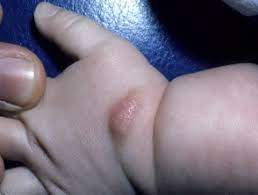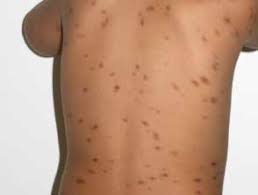A recording of this presentation can be found HERE
***
Many thanks to Dr. Jeff Sugarman, local dermatologist, who gave an excellent Grand Rounds presentation this week on Neonatal and Infant Eruptions: when to worry and when to reassure. See above for the link to watch it.
My notes this week come in the form of a dermatologic photo quiz for your testing pleasure. Answers are below the final photo and question.
1. What is this neonatal rash categorized by fragile pustules that erode very quickly, leaving behind brown collarettes with post-inflammatory hyperpigmentation. It can be present at birth and last days to weeks. More common in neonates with more pigment. Benign.
 |
| Source: DermNetNZ.org |
2. What is this benign newborn rash often caused by over-bundling newborns? Erythematous papules and pustules often occurring on covered portions of the skin. Totally benign.
 |
Source: DermNetNZ.org
|
3. What is this benign rash of the neonatal period, often during the first 1-3 weeks of life, acneiform, often occurring on the face and upper chest and scalp. It has NO comedones and is the result of an inflammatory reaction. Treatment is either topical antifungal or topical 1% hydrocortisone, though no treatment is also acceptable. Often mistaken for neonatal acne, which presents later AND always has comedones.
 |
Source: DermNetNZ.org
|
4. What is this benign self-resolving rash that is notable for pustules on feet and hands that can last for months, come and go in crops, and look a lot like scabies (but when scraped show no mites). This will resolve on its own but can take months to do so?
5. What is this papule on the scalp, often solitary with a unique yellow color? The papule is self-resolving but can last years (5-10) before it disappears. Can sometimes occur in multiples and have extra-cutaneous involvement, with particular issues in the eye. In rare cases, multiple of these are associated with leukemia.
 |
Source: DermNetNZ.org
|
6) What is this condition characterized by peau d'orange (texture). Often missed by primary care clinicians. Usually solitary but can be present in sheets. Featured by pockets of histamine -- Darier's sign when stimulated (scratched or rubbed), can be accentuated. Can last for years. Activated by cold/hot/rubbing.
 |
Source: DermNetNZ.org
|
7) There are four variants of #6: 1) solitary (most common) 2) urticaria pigmentosa with peak onset first year of life 3) diffuse cutaneous mastocytosis and 4) most rarely mast cell leukemia. This is one of those variants, which features flushing, hives, pruritis, blisters and sometimes diarrhea (due to mast cells in the GI system). Treatment involves: antihistamines, oral cromolyn for GI symptoms, consider epi pen. If a high burden of disease, consider monitoring serial serum triptase.
 |
Source: DermNetNZ.org
|
Of note, activators of mast cells include: alcohol, aspirin, narcotics (including codeine), some contrast agents, and hot/cold/sunlight. Consider limiting these triggers in patients with mastocytosis.
8) What is this eyebrow bump, often seen on the lateral brow, caused by a sequestration of ectodermal tissue during embryogenesis? It is usually present at birth but not noticed. It is rubbery, not compressible, not tender. It is also not a true cyst.
Of note, you need to worry when the location suggests a CNS connection, which is always in the midline (25% of midline dermoids have a CNS connection). If a dermoid cyst is leaking clear fluid, this is likely spinal fluid and is BAD. It is good to remember that the neural tube closes in a series of discontinuous zippers, and there is no CNS connection in any other place than the "hot spots" where the zippers close.
9) Do you have to worried about a CNS connection in this infant with a dermoid cyst?
 |
| Source: https://webeye.ophth.uiowa.edu/eyeforum/cases/115-dermoid-cyst.htm |
Of note, dermoid cysts on the lateral brow are generally removed after a child's second birthday. They should be referred to pediatric plastics for the excision for best cosmetic effect.
10) What vitamin deficiency -- often due to inadequate intake and appearing around the time a baby is weaning -- leads to this psoriaform rash (well demarcated) on the face and in the diaper area? Hint: the name of the rash is acrodermatitis enteropathica.
 |
| Source: MDEdge |
11) What is this uniquely pediatric form of this autoimmune disorder, often characterized by raccoon eyes (periorbital accentuation of erythema) and diagnosed by maternal serologies? Hint: photosensitive, 50% of cases have congenital heart block. Rare (10%) have hepatobiliary disease and even rarer (1%) thrombocytopenia.
 |
| Source: DermNetNZ |
12) Cool pearl!! Alternate treatment for umbilical granuloma. Aside from silver nitrate, a study showed that a single application of THIS common household item, covered with bandage tape can resolve this problem. What is the common household item?
13) What is this scary looking fixed erythematous rash (lasting 24+ hours) that often appears on the face, arms and legs. Child tends to be non-toxic appearing, and the trunk is spared. It resolves on its own. It is in the HSP spectrum, but has no cutaneous findings.
 |
| Source: DermNetNZ |
14) Last but not least, what is this rash in a 6 week old baby that did not respond to topical steroid, topical anti-fungal, systemic antihistamines, or antibiotics?
And the bonus final: how do you treat it? Treatment of infantile scabies, even in children under 2 months and <15kg is the same as for children >2 months and >15kg (though the drug labeling does not promote this). Per Dr. Sugarman, you can confidently treat with either oral ivermectin OR topical permethrin safely and effectively in neonates.
********************
No cheating!!! Don't look down here until you have really thought about each of the photo questions above!!
Answers:
1) Transient Neonatal Pustular Melanosis
2) Miliaria Rubra
3) Neonatal cephalic pustulosis
4) Acropustulosis of infancy
5) Juvenile Xanthogranuloma
6) Mastocytosis
7) Urticaria pigmentosa
8) Dermoid Cyst
9) YES! This baby needs imaging (CT or MRI) to rule out encephalocele or mucocele prior to excision).
10) Zinc Deficiency: Treatment is rx zinc 3mg/kg/day
11) Neonatal Lupus Erythematosus
12) Table Salt!! A study of 17 infants with umbilical hernia found 100% resolution (17/17) with a single application of table salt, occluded with medical bandage x 24 hours.
13) Acute hemorrhagic edema of infancy
14) Infant scabies, characterized by vesicles and pustules on the palms and the soles































